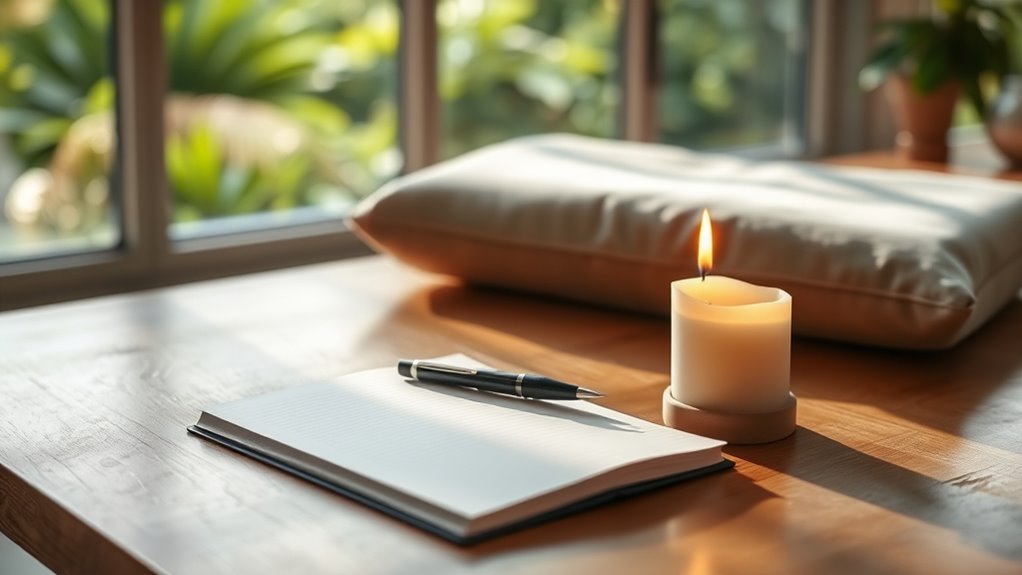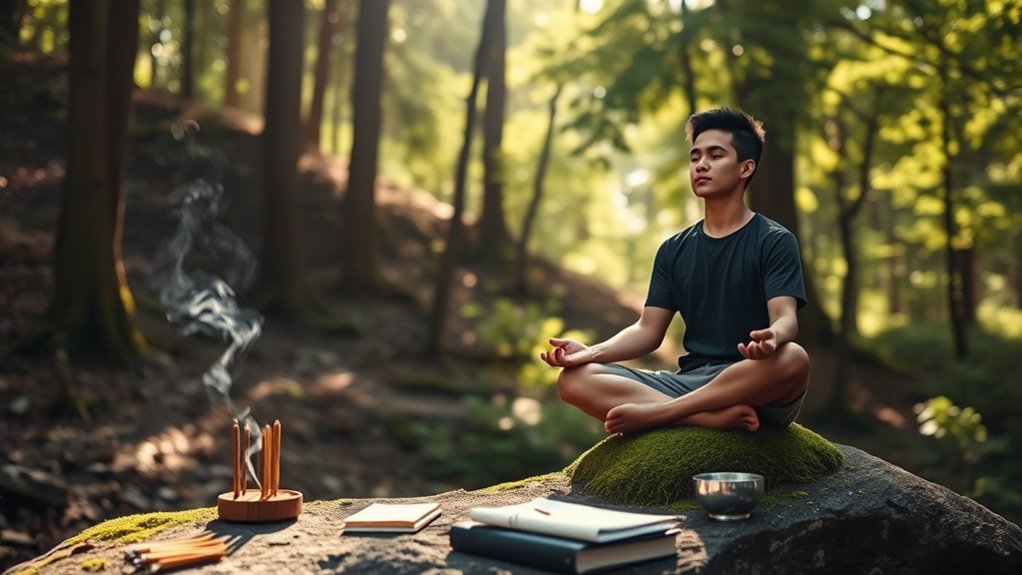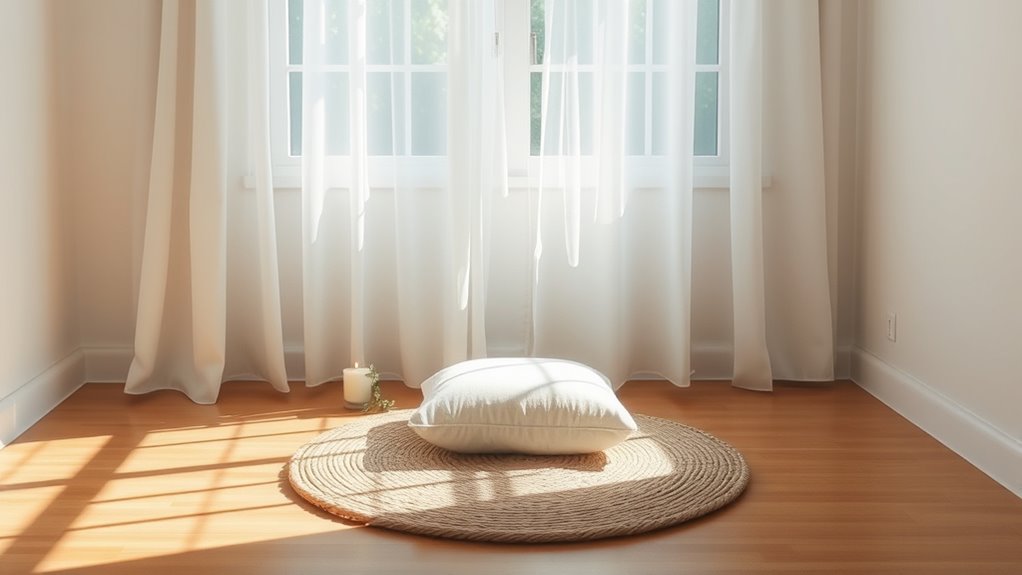To prepare your mind for a silent retreat, start by practicing daily mindfulness through journaling and breath awareness to clarify your intentions and stay present. Simplify your environment by reducing clutter and distractions, and create routines to ease shift. Practice detachment from digital devices and sensory overload to build resilience. Embrace silence gradually, staying patient and open. Continuing further will help you discover more effective ways to cultivate mental clarity and emotional resilience for a deeper retreat experience.
Key Takeaways
- Practice daily mindfulness journaling to clarify goals and set intentions for a purposeful retreat experience.
- Incorporate breath awareness exercises to enhance presence and mental focus before the retreat.
- Reduce environmental distractions by decluttering and establishing routines to create a calm, focused space.
- Develop emotional resilience by recognizing setbacks as growth opportunities and practicing patience during silence.
- Limit digital and sensory overload to deepen concentration and ease the transition into extended periods of silence.
Cultivate Daily Mindfulness Practices

To prepare for your silent retreat, it’s essential to develop a daily mindfulness practice. Start each day with mindfulness journaling, where you reflect on your thoughts, feelings, and sensations without judgment. This helps increase your self-awareness and cultivates a calm mindset. Incorporate breath awareness into your routine by focusing on your breath’s natural rhythm, noticing each inhale and exhale. Practice this for a few minutes daily, gradually extending the duration. As you become more comfortable, you’ll find it easier to stay present and centered during your retreat. Consistent practice trains your mind to remain focused and receptive, making the progression to silence smoother and more meaningful. Developing these habits now prepares you to fully embrace the tranquility of your retreat experience. Additionally, understanding auditory processing techniques can help you better adapt to the sensory environment of the retreat, fostering a more peaceful and receptive state.
Simplify Your Routine and Environment

Simplifying your routine and environment helps create a peaceful space that supports your retreat practice. By reducing clutter and distractions, you foster a sense of calm essential for deep reflection. Opt for minimalist décor, which minimizes visual noise and promotes focus. Sensory reduction is key—limit noise, bright lights, and unnecessary possessions to prevent sensory overload. Consider decluttering your space days before the retreat, so it’s easier to maintain during your time away. Establish routines that streamline daily tasks, freeing up mental space. This clarity allows you to tune into your inner experience without interruption. Creating a simple, serene environment prepares your mind to embrace silence and presence, enhancing your overall retreat experience. Additionally, choosing sulfate-free shampoos and gentle oils for hair care can help maintain your inner calm by avoiding unnecessary chemical distractions in your routine.
Practice Detachment From Distractions

Practicing detachment from distractions requires intentional effort to stay present and focused. To prepare, consider a digital detox by turning off devices and limiting online exposure. This helps reduce mental clutter and enhances your ability to remain centered. Sensory deprivation, like minimizing background noise and unnecessary stimuli, deepens your focus and cultivates calm. Use the following table to identify common distractions and strategies to detach:
| Distraction | Technique to Detach | Benefit |
|---|---|---|
| Phone notifications | Silence or turn off alerts | Reduces interruptions |
| Background noise | Use earplugs or quiet space | Enhances sensory awareness |
| Social media | Limit or schedule time | Prevents mental overload |
| Multitasking | Focus on one task at a time | Improves concentration |
Additionally, understanding the importance of mindfulness can significantly enhance your ability to detach from distractions and stay present during your retreat.
Develop Comfort With Stillness and Silence

You should focus on embracing comfortable silence by allowing yourself to simply be in the moment. Practice mindful stillness daily, noticing your thoughts without judgment. This will help you become more at ease with silence during your retreat. Incorporating mindfulness techniques such as deep breathing and visualization can deepen your experience of tranquility and help maintain focus.
Embrace Comfortable Silence
While stillness and silence may feel uncomfortable at first, embracing them gradually helps you develop a deeper sense of calm and presence. To become more comfortable, focus on mindful breathing, allowing your breath to anchor you in the moment. Cultivate sensory awareness by noticing subtle sounds, sensations, and smells around you, rather than resisting silence. This practice shifts your attention from discomfort to curiosity, making silence feel less intimidating. As you become more familiar with stillness, you’ll notice your mind settling naturally. Remember, patience is key—over time, silence becomes a space for clarity and peace. Incorporating evidence-based tools can further support your journey toward embracing stillness and silence.
Practice Mindful Stillness
Building on your efforts to embrace comfortable silence, cultivating mindful stillness involves intentionally settling into moments of quiet with awareness and acceptance. Start by focusing on your mindful breathing, noticing each inhale and exhale without judgment. As you breathe, expand your sensory awareness to include sounds, sensations, and bodily feelings, observing them without attachment. When your mind drifts, gently bring your attention back to your breath and the present moment. Practice this stillness regularly, even for just a few minutes, to build tolerance for silence and develop a calm, centered mind. Incorporating meditative techniques can deepen your experience and enhance your ability to sit with stillness during your retreat. Over time, you’ll find it easier to sit with stillness during your retreat, deepening your capacity for inner peace and clarity amidst silence.
Set Clear Intentions for Your Retreat

Before commencing on your silent retreat, taking the time to set clear intentions can greatly enhance your experience. Intentions provide focus and purpose, guiding your practice and reflections. Use mindfulness journaling to clarify what you hope to gain, whether it’s inner peace, increased awareness, or emotional clarity. During intention setting, ask yourself meaningful questions like, “What do I want to learn about myself?” or “How do I want to grow?” Write these down to solidify your goals. This process helps you stay centered and motivated throughout your retreat. Remember, clear intentions serve as your compass, ensuring your silent retreat is purposeful and transformative. Focusing on mental clarity can also prepare you for the heightened self-awareness that often comes during silence. Focus on what truly matters to you, and let your intentions shape your journey inward.
Prepare Mentally for Challenges and Emotions

Before your retreat, it’s important to set realistic expectations about what you might experience. You’ll likely encounter challenging emotions or moments of discomfort, but building emotional resilience helps you stay grounded. Preparing your mind in this way guarantees you can navigate difficult feelings with greater ease. Incorporating mindfulness practices, such as meditation, can further strengthen your emotional regulation and enhance your overall experience.
Set Realistic Expectations
While entering a silent retreat can be calming, it’s important to recognize that you may face unexpected challenges and strong emotions along the way. Setting realistic expectations helps with expectation management and enhances your mental preparedness. Accept that discomfort, boredom, or frustration might occur, and see them as part of the process. Acknowledging the importance of mental resilience can help you better navigate difficult moments and maintain focus on your growth. Be prepared for moments of intense self-awareness or emotional release. Remember, silence doesn’t mean absence of difficulty, but an opportunity for growth.
To stay grounded, consider these tips:
- Acknowledge that challenges are normal and temporary
- Avoid idealizing the retreat experience
- Trust your ability to adapt and learn from setbacks
Develop Emotional Resilience
Developing emotional resilience is essential for steering the unpredictable feelings that may surface during your silent retreat. Building grit development helps you stay grounded when discomfort or frustration arise, enabling you to endure challenging moments without losing focus. Cultivating emotional awareness allows you to recognize and accept your emotions without judgment, making it easier to process them calmly. By practicing mindfulness and self-reflection beforehand, you strengthen your capacity to respond thoughtfully rather than react impulsively. Remember, setbacks are part of growth; viewing them as opportunities to deepen your resilience empowers you to navigate the retreat with patience and clarity. Preparing your mind this way guarantees you face emotional challenges with confidence, transforming potential difficulties into valuable learning experiences. Incorporating targeted exercises like self-awareness techniques can further enhance your emotional strength, ensuring a more enriching retreat experience.
Frequently Asked Questions
How Long Should I Gradually Increase My Silent Retreat Duration?
When planning your retreat, you should aim for a gradual progression in your retreat duration. Start with shorter periods, like a day or two, and gradually increase the length over several weeks or months. This approach helps your mind adapt comfortably without feeling overwhelmed. By slowly extending your retreat duration, you build mental resilience and make longer retreats more manageable, ensuring a more meaningful and sustainable silent retreat experience.
What Should I Do if I Experience Overwhelming Emotions During Silence?
Oh, feeling overwhelmed during silence? That’s just perfect timing to practice mindfulness techniques! Instead of resisting, acknowledge your emotions with gentle emotional awareness. Take a deep breath, observe what’s happening without judgment, and let those feelings pass naturally. Remember, silence isn’t about avoiding emotion but learning to sit with it. Embrace the discomfort as part of your growth, and you’ll find your mind becoming more resilient and centered over time.
Are There Specific Foods or Drinks to Avoid Before the Retreat?
You should avoid foods and drinks that might disrupt your focus during the retreat. Practice mindful eating by choosing light, easily digestible meals and avoid heavy or greasy foods. Also, reduce caffeine intake to prevent jitters and sleep disturbances. Staying hydrated with water is best. By making these mindful choices beforehand, you’ll set yourself up for a calmer, more centered retreat experience.
How Can I Maintain Mindfulness Outside of Structured Practice Sessions?
To maintain mindfulness in daily life, you should integrate meditation practices into your routine naturally. Focus on being present during everyday activities like eating, walking, or even washing dishes. Take deep breaths and pay attention to sensations and thoughts without judgment. Consistently practicing mindfulness outside structured sessions helps you stay centered, reduces stress, and strengthens your ability to remain calm and aware throughout your day.
What if I Encounter Physical Discomfort During Extended Stillness?
Imagine you’re midway through a silent retreat and feel sharp discomfort in your leg. You might try mindfulness techniques like gentle body scan or deep breathing to ease pain without judgment. Building physical endurance beforehand helps, but during stillness, acknowledge the discomfort calmly, avoid resistance, and focus on your breath. This approach allows you to stay present, manage physical discomfort, and deepen your mindfulness practice even in challenging moments.
Conclusion
By preparing your mind in advance, you’re more likely to experience deep growth during your retreat. Notably, studies suggest that consistent mindfulness practice can physically change your brain, increasing areas linked to emotional regulation. So, as you train your mind beforehand, you’re not just getting ready—you’re rewiring your brain for lasting calm and clarity. Embrace this preparation; it sets the foundation for a truly transformative silent retreat experience.









